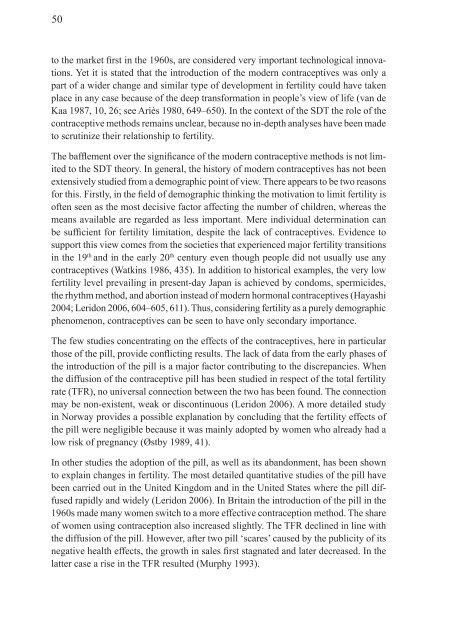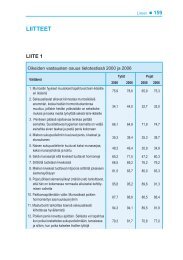Early History of the Oral Contraceptive Pill in Finland ... - Väestöliitto
Early History of the Oral Contraceptive Pill in Finland ... - Väestöliitto
Early History of the Oral Contraceptive Pill in Finland ... - Väestöliitto
Create successful ePaper yourself
Turn your PDF publications into a flip-book with our unique Google optimized e-Paper software.
50<br />
to <strong>the</strong> market first <strong>in</strong> <strong>the</strong> 1960s, are considered very important technological <strong>in</strong>novations.<br />
Yet it is stated that <strong>the</strong> <strong>in</strong>troduction <strong>of</strong> <strong>the</strong> modern contraceptives was only a<br />
part <strong>of</strong> a wider change and similar type <strong>of</strong> development <strong>in</strong> fertility could have taken<br />
place <strong>in</strong> any case because <strong>of</strong> <strong>the</strong> deep transformation <strong>in</strong> people’s view <strong>of</strong> life (van de<br />
Kaa 1987, 10, 26; see Ariès 1980, 649–650). In <strong>the</strong> context <strong>of</strong> <strong>the</strong> SDT <strong>the</strong> role <strong>of</strong> <strong>the</strong><br />
contraceptive methods rema<strong>in</strong>s unclear, because no <strong>in</strong>-depth analyses have been made<br />
to scrut<strong>in</strong>ize <strong>the</strong>ir relationship to fertility.<br />
The bafflement over <strong>the</strong> significance <strong>of</strong> <strong>the</strong> modern contraceptive methods is not limited<br />
to <strong>the</strong> SDT <strong>the</strong>ory. In general, <strong>the</strong> history <strong>of</strong> modern contraceptives has not been<br />
extensively studied from a demographic po<strong>in</strong>t <strong>of</strong> view. There appears to be two reasons<br />
for this. Firstly, <strong>in</strong> <strong>the</strong> field <strong>of</strong> demographic th<strong>in</strong>k<strong>in</strong>g <strong>the</strong> motivation to limit fertility is<br />
<strong>of</strong>ten seen as <strong>the</strong> most decisive factor affect<strong>in</strong>g <strong>the</strong> number <strong>of</strong> children, whereas <strong>the</strong><br />
means available are regarded as less important. Mere <strong>in</strong>dividual determ<strong>in</strong>ation can<br />
be sufficient for fertility limitation, despite <strong>the</strong> lack <strong>of</strong> contraceptives. Evidence to<br />
support this view comes from <strong>the</strong> societies that experienced major fertility transitions<br />
<strong>in</strong> <strong>the</strong> 19 th and <strong>in</strong> <strong>the</strong> early 20 th century even though people did not usually use any<br />
contraceptives (Watk<strong>in</strong>s 1986, 435). In addition to historical examples, <strong>the</strong> very low<br />
fertility level prevail<strong>in</strong>g <strong>in</strong> present-day Japan is achieved by condoms, spermicides,<br />
<strong>the</strong> rhythm method, and abortion <strong>in</strong>stead <strong>of</strong> modern hormonal contraceptives (Hayashi<br />
2004; Leridon 2006, 604–605, 611). Thus, consider<strong>in</strong>g fertility as a purely demographic<br />
phenomenon, contraceptives can be seen to have only secondary importance.<br />
The few studies concentrat<strong>in</strong>g on <strong>the</strong> effects <strong>of</strong> <strong>the</strong> contraceptives, here <strong>in</strong> particular<br />
those <strong>of</strong> <strong>the</strong> pill, provide conflict<strong>in</strong>g results. The lack <strong>of</strong> data from <strong>the</strong> early phases <strong>of</strong><br />
<strong>the</strong> <strong>in</strong>troduction <strong>of</strong> <strong>the</strong> pill is a major factor contribut<strong>in</strong>g to <strong>the</strong> discrepancies. When<br />
<strong>the</strong> diffusion <strong>of</strong> <strong>the</strong> contraceptive pill has been studied <strong>in</strong> respect <strong>of</strong> <strong>the</strong> total fertility<br />
rate (TFR), no universal connection between <strong>the</strong> two has been found. The connection<br />
may be non-existent, weak or discont<strong>in</strong>uous (Leridon 2006). A more detailed study<br />
<strong>in</strong> Norway provides a possible explanation by conclud<strong>in</strong>g that <strong>the</strong> fertility effects <strong>of</strong><br />
<strong>the</strong> pill were negligible because it was ma<strong>in</strong>ly adopted by women who already had a<br />
low risk <strong>of</strong> pregnancy (Østby 1989, 41).<br />
In o<strong>the</strong>r studies <strong>the</strong> adoption <strong>of</strong> <strong>the</strong> pill, as well as its abandonment, has been shown<br />
to expla<strong>in</strong> changes <strong>in</strong> fertility. The most detailed quantitative studies <strong>of</strong> <strong>the</strong> pill have<br />
been carried out <strong>in</strong> <strong>the</strong> United K<strong>in</strong>gdom and <strong>in</strong> <strong>the</strong> United States where <strong>the</strong> pill diffused<br />
rapidly and widely (Leridon 2006). In Brita<strong>in</strong> <strong>the</strong> <strong>in</strong>troduction <strong>of</strong> <strong>the</strong> pill <strong>in</strong> <strong>the</strong><br />
1960s made many women switch to a more effective contraception method. The share<br />
<strong>of</strong> women us<strong>in</strong>g contraception also <strong>in</strong>creased slightly. The TFR decl<strong>in</strong>ed <strong>in</strong> l<strong>in</strong>e with<br />
<strong>the</strong> diffusion <strong>of</strong> <strong>the</strong> pill. However, after two pill ‘scares’ caused by <strong>the</strong> publicity <strong>of</strong> its<br />
negative health effects, <strong>the</strong> growth <strong>in</strong> sales first stagnated and later decreased. In <strong>the</strong><br />
latter case a rise <strong>in</strong> <strong>the</strong> TFR resulted (Murphy 1993).

















